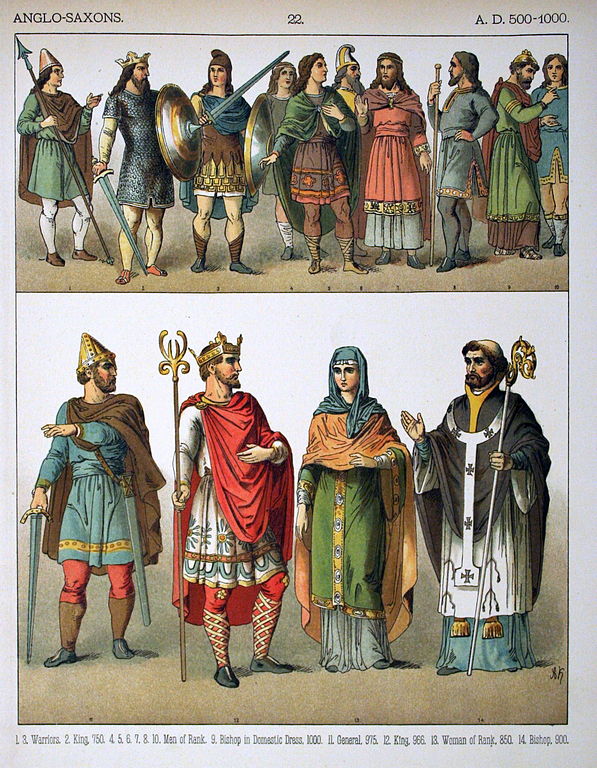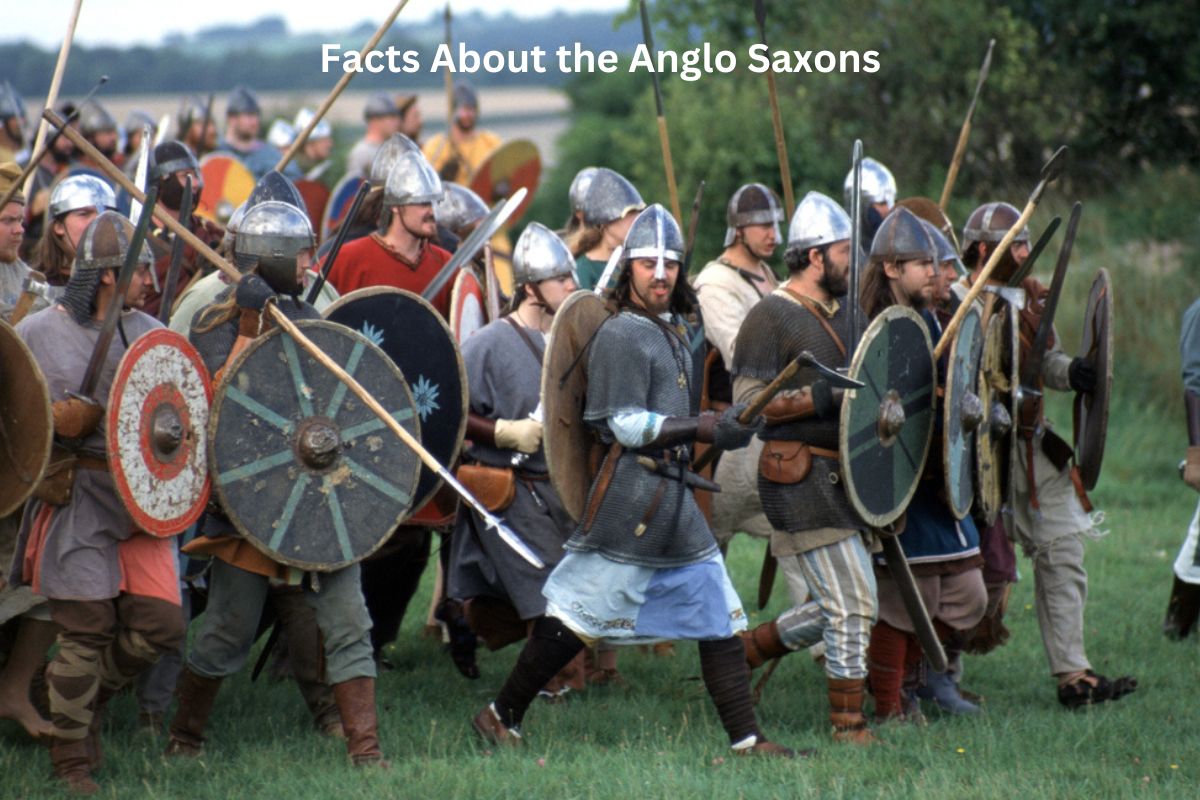The Anglo-Saxons, Germanic tribes who settled in England in the early Middle Ages, profoundly influenced the land, culture, and institutions of what would later become England.
Originating from regions like modern Germany and Denmark, they arrived in England after the decline of Roman rule, introducing their language, Old English, and tribal traditions. Initially pagans, they gradually converted to Christianity through missionaries like St. Augustine.
The Anglo-Saxon era featured competing kingdoms, including Wessex and Mercia, often marked by Viking invasions and the creation of Viking-controlled territories known as the Danelaw.
Their cultural contributions include the epic poem “Beowulf” and intricate metalwork and manuscripts. Their legacy persists in modern English language and culture, as the Anglo-Saxon period laid the foundation for England’s development.
Anglo Saxons Facts
1. They migrated to England from Germany, Denmark, and the Netherlands
The Anglo-Saxons began migrating to England in the 5th century AD. This migration was a result of various factors, including population pressures in their homelands and the decline of Roman rule in Britain.
Also Read: Facts About the Normans
As they arrived, they settled in different regions, with the Angles primarily in the east and north, the Saxons in the south, and the Jutes in the southeast. These groups collectively became known as the Anglo-Saxons.
2. They spoke Old English
The Anglo-Saxons spoke Old English, which is the earliest form of the English language. Old English had Germanic roots and was significantly influenced by the languages of the Anglo-Saxon tribes.
Also Read: Timeline of the Anglo Saxons
It is characterized by its use of runic writing and is quite distinct from the Modern English we use today. Many words in Modern English have their origins in Old English, showcasing the lasting linguistic influence of the Anglo-Saxons.

3. Initially practiced Germanic paganism, later converted to Christianity
When the Anglo-Saxons first arrived in England, they practiced Germanic paganism. They worshiped a pantheon of gods and goddesses, including Woden (Odin), Thunor (Thor), and Frige (Frigg). They had a complex set of beliefs and rituals, often involving sacrifices and ceremonies tied to natural cycles.
The conversion of the Anglo-Saxons to Christianity was a gradual process. It began in the 6th century with the arrival of missionaries from Rome, most notably St. Augustine of Canterbury. These missionaries aimed to replace pagan beliefs with Christianity.
Over time, kings and nobles began to convert, and Christian monasteries and churches were established. By the 7th century, Christianity had gained a foothold and eventually became the dominant religion in England.
This religious shift had a profound impact on the culture, art, and governance of the Anglo-Saxon kingdoms.
4. The Christian conversion began with missionaries like St. Augustine of Canterbury
The Christianization of the Anglo-Saxons was a pivotal development during their time in England. Here’s a more detailed look at this process:
- Arrival of Missionaries: The conversion to Christianity began with the arrival of Christian missionaries from the continent. The most famous of these missionaries was St. Augustine of Canterbury, who arrived in 597 AD under the authority of Pope Gregory the Great. His mission was to convert the Anglo-Saxons, starting with the kingdom of Kent.
- Conversion of Kings: The conversion of Anglo-Saxon rulers played a crucial role in the spread of Christianity. King Æthelberht of Kent was one of the first Anglo-Saxon kings to convert, and this conversion set an example for others. As kings converted, their subjects often followed suit, leading to the gradual Christianization of the Anglo-Saxon kingdoms.
- Monastic Communities: Monasteries played a significant role in the Christianization process. Monks and nuns from these religious communities not only provided spiritual guidance but also acted as centers of learning and culture. They copied and preserved important texts, including religious manuscripts.
- Synods and Councils: Church synods and councils were convened to establish Christian doctrine and ecclesiastical organization. The Synod of Whitby in 664 AD, for example, resolved differences in Christian practices between the Roman tradition and the Celtic tradition and helped unify Christian practices in England.
5. Anglo-Saxon England consisted of various kingdoms, including Wessex and Mercia
During the Anglo-Saxon period, England was divided into several distinct kingdoms, each with its own rulers and territories. Some of the major kingdoms included:
- Wessex: Located in the southwest, Wessex became one of the most powerful Anglo-Saxon kingdoms under the rule of King Alfred the Great. Alfred is known for his efforts to defend his kingdom against Viking invasions and for his contributions to the development of English law and education.
- Mercia: Mercia was a powerful kingdom in central England. It often vied for dominance with other kingdoms, including Wessex and Northumbria. Mercia produced notable rulers like Offa, who is known for constructing Offa’s Dyke, a defensive earthwork along the border with Wales.
- Northumbria: Located in the north, Northumbria had both Anglo-Saxon and Celtic influences due to its proximity to Scotland. It was known for its centers of learning, including the famous monastery at Lindisfarne.
- East Anglia: This kingdom was situated in the eastern part of England. It played a significant role in the early Christianization of the Anglo-Saxons.

6. Viking invasions led to the establishment of the Danelaw
The 8th and 9th centuries saw a series of Viking raids and invasions in England. These Norse seafarers, often referred to as Vikings, attacked coastal settlements and monasteries, causing widespread disruption. As a result of these incursions:
- Danelaw: The Vikings established control over certain areas of England, primarily in the east and north. This region, known as the Danelaw, followed Danish legal and administrative customs.
- Integration and Conflicts: In some cases, Vikings integrated with the local Anglo-Saxon population through intermarriage and trade. In other instances, there were conflicts between the Anglo-Saxon kingdoms and Viking invaders, resulting in battles and territorial shifts.
- Alfred the Great: King Alfred of Wessex is particularly celebrated for his efforts to defend his kingdom against Viking invasions. His leadership and strategic reforms played a crucial role in resisting the Viking incursions.
Also Read: Alfred the Great Facts
The Viking Age in England eventually led to a more unified English kingdom as Anglo-Saxon rulers and leaders like King Alfred worked to push back the Viking invaders and reclaim lost territories.
7. The Anglo-Saxon Chronicle is an important historical text from this period
The Anglo-Saxon Chronicle is an essential historical source for understanding the history of the Anglo-Saxon period. Here are more details about this chronicle:
- Compilation: The Anglo-Saxon Chronicle is a collection of annals, or historical entries, that record significant events in England from the 9th to the 12th centuries. These entries were originally recorded in Old English by various authors and later compiled into a single manuscript.
- Multiple Manuscripts: Several versions of the chronicle exist, and they were maintained at different monastic centers across England. Each version reflects the perspective and interests of the local scribes who contributed to it.
- Content: The entries in the chronicle cover a wide range of topics, including battles, royal successions, natural disasters, and notable events. It provides valuable insights into the political, social, and cultural history of the Anglo-Saxon period.
8. Notable Anglo-Saxon literature includes “Beowulf”
Anglo-Saxon literature and poetry are celebrated for their cultural significance and artistic merit. Here are some key points:
- “Beowulf”: “Beowulf” is the most famous work of Anglo-Saxon literature. It is an epic poem that tells the story of a heroic warrior named Beowulf who battles monsters and dragons. The poem is rich in themes of heroism, fate, and the struggles of the human condition.
- “Exeter Book” and Other Manuscripts: The “Exeter Book” is another notable manuscript from this era, containing a variety of Old English poems and religious texts. It provides insights into the religious and literary life of the Anglo-Saxons.
- Alliteration and Kennings: Anglo-Saxon poetry often used alliteration and kennings, which are poetic devices that involve the repetition of initial consonant sounds and metaphorical expressions, respectively.
9. They were skilled in metalwork and jewelry making
Anglo-Saxon art and craftsmanship are known for their intricate and skilled work. Here are more details:
- Metalwork: Anglo-Saxon artisans were skilled in working with precious metals, such as gold and silver. They created exquisite jewelry, including brooches, necklaces, and intricate belt fittings.
- Manuscript Illuminations: Illuminated manuscripts from the Anglo-Saxon period are also highly regarded. Scribes and artists embellished manuscripts with intricate illustrations, often depicting religious scenes.
- Sutton Hoo: The Sutton Hoo burial site is one of the most famous archaeological discoveries from the Anglo-Saxon period. It contained a ship burial filled with treasures, including a helmet, weaponry, and jewelry, showcasing the craftsmanship of the time.
10. Their legacy is still evident in English culture and language
The legacy of the Anglo-Saxons is still evident in various aspects of English culture and language:
- Language Influence: Old English, the language of the Anglo-Saxons, has left a lasting impact on the English language. Many words and phrases in modern English have their roots in Old English.
- Legal and Governance Traditions: Some elements of Anglo-Saxon legal and governance traditions, such as the concept of the “witenagemot” (a council of nobles), influenced the development of English institutions.
- Place Names: Many place names in England reflect the Anglo-Saxon heritage. Names ending in “-ton,” “-ham,” and “-ing” often indicate Anglo-Saxon origins.
- Cultural Identity: The Anglo-Saxon period is seen as a formative period in the development of English identity and culture, and it is celebrated in literature, historical reenactments, and cultural festivals in England today.
